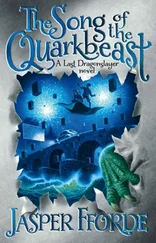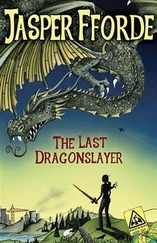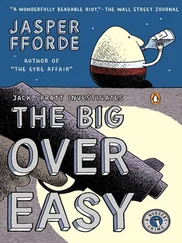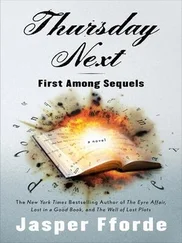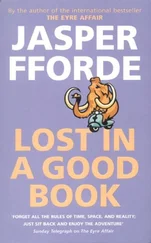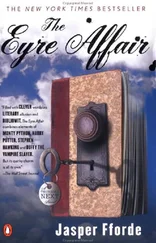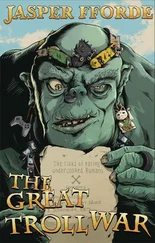‘Possibly. Still, can’t be helped.’
He lowered the snow plough and moved forward. But as he did so, the trace moved away from us. Hooke stopped, and the trace shifted on for a few yards, stopped, paused, then approached us again. A squall of wind hit the Sno-Trac and the vehicle shook. The anemometer on the roof was reading gusts of sixty miles per hour, but the whatever-it-was on the H4S seemed unaffected.
There was silence in the cab for a moment and then, with a slowness that denoted clear deliberation, the radar trace started moving towards us.
‘After a scrap, are you?’ said Hooke, and took the Cowpuncher off the rack behind him. He pushed four D-Cell thermalites into the magazine and racked the first into the battery chamber. The Cowpuncher was not the subtlest of weapons – it was actually intended for herding dairy mammoths rather than fighting – but was the close-quarter weapon of choice when you weren’t big on subtlety and hostility was getting right in your face.
Hooke slid back the window and held the weapon outside while we both stared at the H4S screen, the trace moving ever closer. When it was at the ten-yard range, Hooke let fly.
The pressure wave momentarily turned the snow to rain and should have revealed whatever it was in the blizzard, but there was nothing to be seen except the side of the road and one half of a horse trough. Within a second the blizzard had once more closed in and by the time we looked back at the H4S screen, the radar return had gone.
‘Must have been a glitch,’ said Hooke.
‘No,’ I said, pointing at the bottom of the screen, ‘I think it’s behind us.’
The H4S scanner was mounted on the top of the Sno-Trac and gave a 360-degree view of the surroundings. It was now picking up a trace directly behind, and moving slowly left to right.
‘I’ve had enough of this,’ said Hooke, and drove backwards as fast as he could. I felt a thump and then a judder as we hit something, and he stopped.
‘We got it, whatever it was. Bear, I think.’
‘Why would a bear not hibernate? That never happens.’
‘First time for everything. I’m—’
He’d stopped talking because the electrical power in the Sno-Trac had died, and with it the lights, H4S and engine. The only thing still working was the AM wireless, the dial a dull orange. It was tuned to the Winter Network, and now the engine was off we could hear the music – a crackly rendering of ‘Getting to Know You’ . The implication of a Rodgers and Hammerstein track wasn’t lost on Hooke, and he went to switch the wireless off, but the knob broke off in his fingers.
‘The plastic must have been fatigued by the cold,’ I said, but if I thought this situation was in any way good, I was mistaken. The auxiliary heater had died with the power outtage and Sno-Tracs were not well insulated. Without heating they’d match the exterior temperature in less than ten minutes.
‘Bad time to have a breakdown,’ said Hooke, checking all the trips. After cracking a light-stick, he pressed the starter and the compressed air turned the engine but without a restart, and that’s when we felt the vehicle lurch violently to one side. We exchanged looks.
‘It’s dragging us backwards,’ I said. ‘You must have snagged her.’
‘Not for long,’ he replied, his temper up. He selected low reverse, let out the clutch and then pressed the air starter. The compressed air hissed into the engine, turned the motor over without a start but it moved the Sno-Trac regardless, jerkily, and in reverse; he was attempting to run over what was pulling us. There was another lurch, the vehicle lifted as it went over an obstruction, then fell to the ground again and stopped hard; we’d struck a wall or something. Hooke pushed the gear selector into first and pressed the starter again but there was only a faint hiss as the compressed air tank ran out – we were going nowhere.
‘Stay here,’ said Hooke, grabbing the Cowpuncher. ‘Me and it need to get some face time.’
He opened the rear door and the cab was suddenly full of wind-borne snow.
‘Safety line,’ I reminded him, shivering with the sudden cold, and he nodded, grabbed the safety cable, clipped it to his belt and dropped out of the cab and into the blizzard.
Once the door had shut, the snowflakes that had blown into the cab settled and turned to water in the warm interior. The ratchet on the steel safety reel began to pay out, matching Hooke’s cautious walking speed. After about a half-minute it stopped. And then, softened by the storm, there was a distant thud – Hooke had deployed the Cowpuncher. A second or two later and there was a howl of noise as the safety reel paid out at a furious rate. Within ten seconds the entire fifty-yard length had gone and the reel came to a juddering halt. The tensioned wire bit into the drum and door surround, bent the mounting spindle and jerked the entire Sno-Trac sideways. The cable stayed taut for a second, then went slack.
I sat there for a few minutes with the wind buffeting the Sno-Trac, the temperature falling. My breath was now showing white in the chill air, and the moisture in the cab was beginning to freeze on the inside of the windscreen and instrument panel. This was not good news: in the rush to leave the Siddons , I’d left my heavy coat, gloves, hat and overboots behind. If I didn’t do anything, in a couple of hours I’d be solid until the thaw.
Just as I was trying to figure out my best option the lights flickered back on as electrical power returned. I jumped into the driver’s seat, checked the Trac was in neutral, turned on the ignition and then pushed the air starter. Nothing. The H4S had powered up again, and the creature was visible only as a whispering collection of greenish spots on the screen in front of me, reinforced by every sweep of the scanner. The trace moved, took a pace forward, then stopped, and by the time the scanner came around again, it had gone. There was just me, the blizzard and an immobile Sno-Trac.
I shivered again and realised that notwithstanding the apparent safety of the vehicle, I needed to make a move now while I was still warm enough to do so. I rummaged in the back of the Sno-Trac and found a pair of socks, a flat cap and a spare woncho. I put the woncho over my head and pulled the hat down as far as I could, then slipped the woolly socks on my hands to use as gloves. I took the emergency lantern from its place on the bulkhead, pushed in a thermalite and switched it on. There was a soft fizz and the cabin was flooded by a warm orange glow. I looked at the temperature gauge and wind speed, and figured I had perhaps ten minutes to find shelter or I’d be next in line for a multiple finger transplant. Leave it twenty minutes and I could upgrade the loss to that of a foot, nose or hand. Half an hour and I’d probably be dead.
I popped the door release and was once more buffeted by the wind and the snow. I lowered myself to the ground, the wind tugging at the woncho and cutting into my cheeks, while small flakes of snow sneaked through my clothing to thaw on my warm flesh. The ground yielded soft underfoot; there was about eighteen inches of snow. The lantern made little headway in the blizzard so in the absence of any better ideas I wrapped Hooke’s safety cable in the crook of my arm and followed it away from the Sno-Trac. Now in the full force of the wind, I crouched lower as I walked to minimise the effect of the gale, which at every step threatened to push me off balance.
I followed the cable for thirty or so paces and was relieved to see a flicker of light, but it turned out to be only a street lamp, the small gas flame battling to stay alight. Another minute of slow trudge took me to the end of the cable, which was attached to Hooke’s over-trousers, which were neatly folded in a pile along with everything else he’d been wearing, his boots placed on top. Hooke was close by, his head twisted around to the left and a lump showing through on his neck where it had been broken. He wore a look of surprise on his rapidly chilling features, his eyes and mouth wide open. Like Lucky Ned, his little finger was missing. It was the Gronk, and she was taking souvenirs.
Читать дальше



